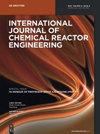Eco friendly synthesis of epoxidized palm oleic acid in acidic ion exchange resin
IF 1.6
4区 工程技术
Q3 Chemical Engineering
International Journal of Chemical Reactor Engineering
Pub Date : 2023-03-14
DOI:10.1515/ijcre-2023-0017
引用次数: 0
Abstract
Abstract Global raw material use has moved from a non-renewable to a renewable resource. Additionally, the research on epoxidation has produced a safer, more cost-effective, and ecologically friendly product than non-renewable resources. At present, there are limited studies on the production of epoxidized palm oleic acid using eco-friendly ion exchange resin method. Consequently, the objective of this study is to optimise the reaction conditions of epoxidation palm oleic acid using ion exchange resin (amberlite IR 120H) as a catalyst. Epoxidized palm oleic acid was prepared using performic acid formed in situ by mixing formic acid with hydrogen peroxide. The results showed that the optimum reaction conditions for the production of oxirane content were a temperature of 75 °C and a hydrogen peroxide concentration of 30%. The maximum relative conversion of palm oleic acid to oxirane was achieved using the optimum conditions with up to 75%. Finally, a mathematical model was developed using MATLAB and the fourth-order Runge–Kutta method was integrated with the genetic algorithm to determine the reaction rate, which was consistent with the experimental data. This study proved that palm oleic acid was successfully converted into a green epoxide that promotes the use of palm oil as a raw material.在酸性离子交换树脂中环保合成环氧化棕榈油酸
摘要全球原材料使用已从不可再生资源转向可再生资源。此外,环氧化研究产生了一种比不可再生资源更安全、更具成本效益和生态友好的产品。目前,采用环保型离子交换树脂法生产环氧化棕榈油酸的研究有限。因此,本研究的目的是优化使用离子交换树脂(amberlite IR 120H)作为催化剂的环氧化棕榈油酸的反应条件。用甲酸和过氧化氢混合原位形成的过孔酸制备了环氧化棕榈油酸。结果表明,生产环氧乙烷含量的最佳反应条件是温度为75°C,过氧化氢浓度为30%。在最佳条件下,棕榈油酸向环氧乙烷的最大相对转化率达到75%。最后,使用MATLAB建立了数学模型,并将四阶Runge–Kutta方法与遗传算法相结合来确定反应速率,这与实验数据一致。该研究证明,棕榈油酸成功转化为绿色环氧化物,促进了棕榈油作为原料的使用。
本文章由计算机程序翻译,如有差异,请以英文原文为准。
求助全文
约1分钟内获得全文
求助全文
来源期刊
CiteScore
2.80
自引率
12.50%
发文量
107
审稿时长
3 months
期刊介绍:
The International Journal of Chemical Reactor Engineering covers the broad fields of theoretical and applied reactor engineering. The IJCRE covers topics drawn from the substantial areas of overlap between catalysis, reaction and reactor engineering. The journal is presently edited by Hugo de Lasa and Charles Xu, counting with an impressive list of Editorial Board leading specialists in chemical reactor engineering. Authors include notable international professors and R&D industry leaders.

 求助内容:
求助内容: 应助结果提醒方式:
应助结果提醒方式:


